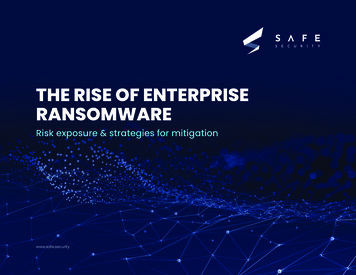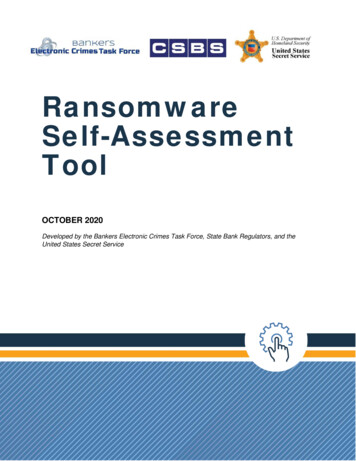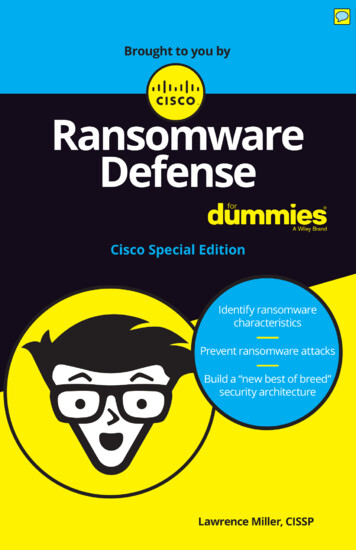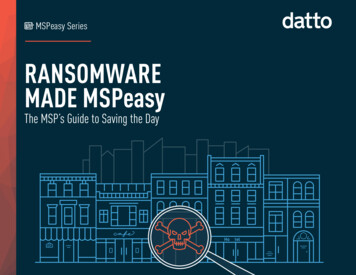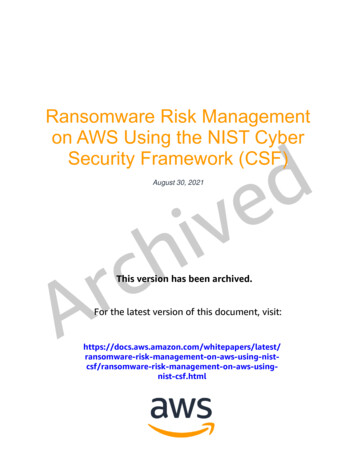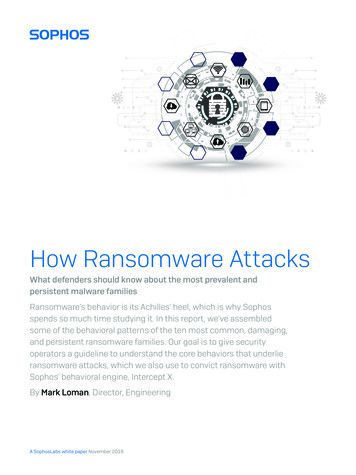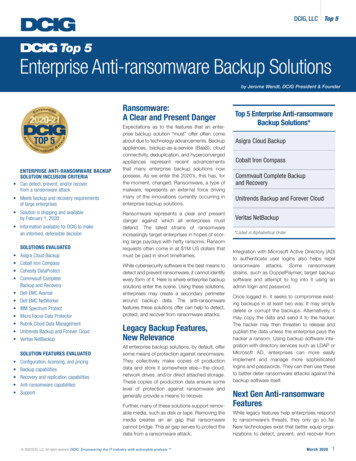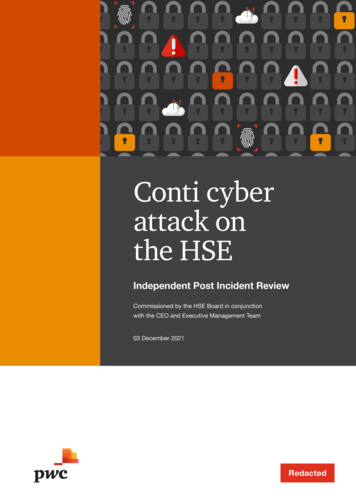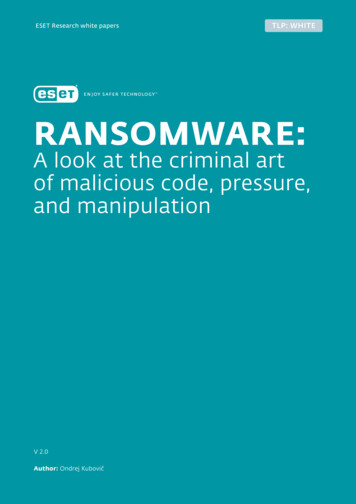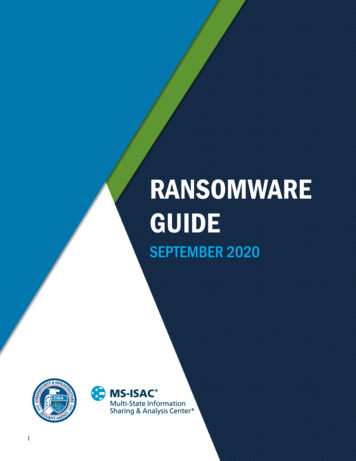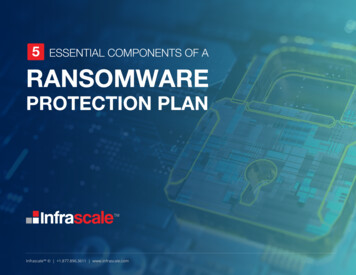
Transcription
5ESSENTIAL COMPONENTS OF ARANSOMWAREPROTECTION PLANInfrascale 1.877.896.3611 www.infrascale.com
Ransomware attacks continue to be a threat to organizations of all types and sizes. The Verizon 2021 Data BreachInvestigations Report (DBIR) states, “The major change this year with regard to action types was Ransomwarecoming out like a champ and grabbing third place in breaches (appearing in 10% of them, more than doubling itsfrequency from last year).”The report authors propose this could be due to, “the shift in tactics of the actors who ‘named and shamed’ theirvictims. These actors will first exfiltrate the data they encrypt so that they can threaten to reveal it publicly if thevictim does not pay the ransom.”Ransomware has indeed been a “champ” in that it often defeats and surpasses rivals. It is almost impossible tostop every infection. The best plan is to prevent attacks from succeeding and have a plan for recovering if they do.In this brief guide, we’ll cover the top tips for preventing ransomware attacks, and coping with those that prevail.Organizations of All Sizes and Types Are Being TargetedOften, SMBs believe their small size provides a level of protection, since largerenterprises with larger budgets are more attractive targets. But 43% of cyberattacksare aimed at small businesses. Attacks are rarely publicized since many SMBs aren’tsubject to the same reporting regulations as larger enterprises.Organizations of all kinds have suffered ransomware attacks, including BaltimoreCounty Public Schools and the Athens Independent School District, which paid aransom of 50,000 to recover its data in addition to delaying first day of school.According to the McAfee Threats Report: June 2021, “Victims are paying the ransoms,and criminals are introducing more Ransomware-as-a-Service (RaaS) schemes as a result.”Data of All Kinds is Being TargetedWhile it’s important to protect payment data, it’s not the only data attacks are targeting.The Verizon 2021 DBIR states, “Attackers are less likely to purely target payment dataand are more likely to broadly target any data that will impact the victim organization’soperations. This will increase the likelihood that the organization will pay up in aRansomware incident.”Infrascale 1.877.896.3611 www.infrascale.com02
NDCTSPOCTOTEPRFRAMEWORKREPlans for preventing and responding toransomware attacks can be broken into five corecomponents, which align with cybersecurity bestpractices, specifically, the NIST CSF (NationalInstitute of Standards and TechnologyCybersecurity Framework) CybersecurityFramework.NTIDE IFYRECOVER5 ESSENTIAL COMPONENTS OF ARANSOMWARE PROTECTION PLANDETE01 IDENTIFYStart with a thorough understanding of the scope of your assets, systems, data, people, and capabilities. Risk tolerance varies for differentorganizations, so you must consider the risks to your organization, and the specific impacts of different systems being rendered inoperable.Consider any needs to comply with regulations such as PCI DSS.NIST CSF states, “Understanding the business context, the resources that support critical functions, and the related cybersecurity risks enables anorganization to focus and prioritize its efforts, consistent with its risk management strategy and business needs.”Determine your approach through an analysis, weighed against the desired risk tolerance of your business. Building from the foundation of thisassessment, you can prioritize the investment of funds and time to establish the security posture that’s ideal for your organization.Infrascale 1.877.896.3611 www.infrascale.com0203
02 PROTECTCreate technical and administrative safeguards to prevent a potential cybersecurity incidentwhich can impact the delivery of critical services and business processes.Create SafeguardsSafeguards must incorporate all the ways your business operates, and be appropriatelysized, based on your assessment and risk tolerance, as defined in step one.A crucial cybersecurity tenet, least privilege means giving people only the permissions theyneed to get their job done. Role-based access controls restrict system access to authorizedusers, and further restricts what each user can access. Not only users, but systems shouldalso have least privilege, for example, an AWS Lambda function that reads a database shouldhave no privileges beyond reading. Least privilege inhibits the ability for attackers to spreadlaterally throughout your infrastructure to hunt for sensitive data and spread infections.Other vital protection measures include:Processes for reviewing vendorsUtilize multi-factor authentication, among the FBI’s best practices tominimize ransomware risksEnsure your security solutions are up to dateAntivirus (AV) softwareMinimize Risks with Controlled AccessStiving for a Zero Trust methodology improves risk posture, further reducing the risk ofransomware. Gartner’s “Guide to Network Security Concepts,” states, “Zero trust architecture(ZTA) is a true paradigm shift in network security, but don’t try to go out and buy it. As aproduct, it does not exist, even though many vendors market their products as ‘zero trust.”While Zero Trust can mean different things to different people, it’s a security frameworkfocused on securing applications and data, rather than securing only the network.Infrascale 1.877.896.3611 www.infrascale.com04
02 PROTECT (cont.)Secure Common Ransomware Entry PointsEndpoints, specifically employee endpoints, are compromised more easily and arecommon ransomware attack vectors. This makes endpoint protection one of the mostimportant components of ransomware prevention. The McAfee Threats Report: June 2021states, “When it comes to the actual ransomware binary, we strongly advise updating andupgrading your endpoint protection, as well as enabling options like tamper protectionand rollback.”Keep your operating system and application software updated and patched. This mightsound obvious, but endpoints (like a laptop or desktop computer) are not as sophisticatedas servers when running. End-user computers typically run many applications fromdifferent vendors. IT policy management tools can help administrators and end-usersmanage patches and enforce policy around software application versioning.Be Prepared by Backing Up Your DataSince “un-hackable” doesn’t exist, every organization needs a comprehensive backup anddisaster recovery solution. Just like platforms and software applications, disaster recoveryis available “as a service.” DRaaS is a service model that provides backup and recovery viathe use of a third-party cloud environment, whereby all of the disaster recoveryfunctionality, including orchestration, are provided as-a-service. Be sure your recovery planalso includes backup for the data in your SaaS applications, endpoints, and servers.Prepare and Ensure You’re Prepared by Conducting DrillsDon’t just implement backups but test them regularly. Conduct drills to battle-test yourorganization’s risk management and incident response.Educate EmployeesEmployees must fully understand the threats posed by attacks such as phishing. Accordingto the McAfee Threats Report: June 2021, “Spear Phishing (Link and Attachment) movedback to the top 5 used Techniques.” Training helps users determine which emails not toopen, and how to identify malicious senders and suspicious attachments, reducing theirrisk of falling prey.Infrascale 1.877.896.3611 www.infrascale.com05
03 DETECT AND CONTINUALLY IMPROVEImplement the appropriate actions to identify abnormal or malicious activity in yourenvironment. Detection enables timely discovery of cybersecurity events and includessecurity continuous monitoring.Monitor ConstantlyThe ability to detect attacks, both attempts and successful breaches, is vital to preventingbusiness disruptions and mitigating risks. Continuous, integrated monitoring capabilitiesare needed.Anomaly detection can provide early warnings, enabling companies to quickly isolate aransomware infection, revert to a clean backup, and recover important data before theentire network freezes.Endpoint Detection and Response (EDR)As bad actors continually adapt their attack techniques, they can be successful incircumventing AV software. This is where Endpoint Detection and Response (EDR) can helpby looking for bad behavior and alerting the end-user or administrator.Earlier warning of infection increases response time to stop the spread of the infection –and better yet – illuminate the exact timestamp of infection so that the exact recovery pointis known.Continually ImproveInfo security programs must be continually amended and updated. The NIST CSFframework is displayed in a wheel, visualizing this concept of constant improvement andadaptation.Incorporate continual improvement plans to address gaps in your visibility and protections.Evaluate all of your alarms and monitors and confirm your responses and processes areoptimized. For example, if you’re seeing numerous alarms for spam or malware, revisit steptwo and implement new security tools or alter your existing tools to improve yourprotections in light of these threats.Infrascale 1.877.896.3611 www.infrascale.com06
04 RESPONDDevelop and practice an incident response program within your organization that can beactivated to help contain the impact of security events, including ransomware. You neednot only visibility, but processes for responding, in addition to practicing your establishedprocesses.Determine When the Infection StartedBefore you can restore your clean files from backup, you need to know how far back to goto ensure a clean restore. The timeline for discovering breaches continues to shrink, andwith ransomware, attackers notify victims of the attack. (A necessary step in order todemand ransom.) Many recent ransomware attacks have featured a countdown timer,badgering victims to pay before time runs out. Still, so you can’t rely on being informedpromptly and could have been infected for weeks prior to receiving the ransomwaremessage. Attackers aren’t known for their reliability, and they may deliberately wait for theinfection to spread.Minimize the DamageSystems such as Endpoint Detection and Response (EDR) must immediately generatewarning notifications to enable administrative action in real-time.Identify, isolate, and remove the infected computer(s). Disconnect from the networkimmediately, so ransomware cannot spread to shared drives and connected systems.Inform employeesEnsure that all employees are aware that a ransomware attack is in process and directthem to the processes and procedures needed to protect their data. Provide a timeframefor restoration of affected systems.Infrascale 1.877.896.3611 www.infrascale.com07
05 RECOVERBuild a cyber resilience program, including a back-up and restoration strategy to restorecore functionality and avoid the expense of hours of downtime. This must includeprotecting not just data stored on-premises, but in various cloud and SaaS providers. Yourdata should always be protected and always available on your time. To fully recover fromdisaster requires the ability to backup mobile devices, laptops, or remote offices.With a backup and DR plan in place, you won’t need to pay the ransom to access your dataand continue operations.Restore the DataLook for solutions such as Infrascale Cloud Backup (ICB) that are easy to deploy, install, andmanage directly from one unified console. The Infrascale Dashboard is designed withefficiency in mind, with simple single-pane-of-glass management of SaaS backups. IBDR alsoprovides the option to lease the BDR hardware with no upfront CapEx, or purchase theequipment if desired.Prevent ReinfectionBusinesses often pay the ransom and get the decrypt key but find themselves faced withre-encryption and a new ransom demand a month later. Victims must ensure completeremoval of the ransomware to avoid a continuous infection cycle.Infrascale 1.877.896.3611 www.infrascale.com08
CONCLUSIONAs hard as IT pros are working to thwart attackers, attackers are dedicating efforts to circumventing their protections.Additionally, many attackers succeed simply due to human error rather than their own sophistication. Protectingagainst ransomware involves both establishing a secure posture to increase resistance to attacks, while also expectingthose defenses to fail and being prepared with backup and disaster recovery.Ransomware Protection with Infrascale Cloud Backup (ICB)Infrascale Cloud Backup (ICB) is a direct-to-cloud endpoint backup solution that protects business devices includinglaptops and desktops – as well as servers including Microsoft Exchange and SQL databases – all in one solution. ICBoffers unlimited data retention and version history for an unlimited number of endpoint devices, captures real-timechanges via Live Protect, and safeguards against ransomware threats with advanced anomaly detection.About InfrascaleFounded in 2011, Infrascale provides comprehensive, cloud-based data protection by deliveringindustry-leading backup and disaster recovery solutions. Combining intelligent software with the power of thecloud, Infrascale removes the barriers and complexity of secure, offsite data storage and standby infrastructurefor real-time disaster recovery. Trusted and recommended by leading independent industry experts, Infrascaleequips its customers with the confidence to handle the unexpected by providing greater availability, bettersecurity, and less downtime when it comes to their data.Infrascale 1.877.896.3611 www.infrascale.com09
common ransomware attack vectors. This makes endpoint protection one of the most important components of ransomware prevention. The McAfee Threats Report: June 2021 states, "When it comes to the actual ransomware binary, we strongly advise updating and upgrading your endpoint protection, as well as enabling options like tamper protection
